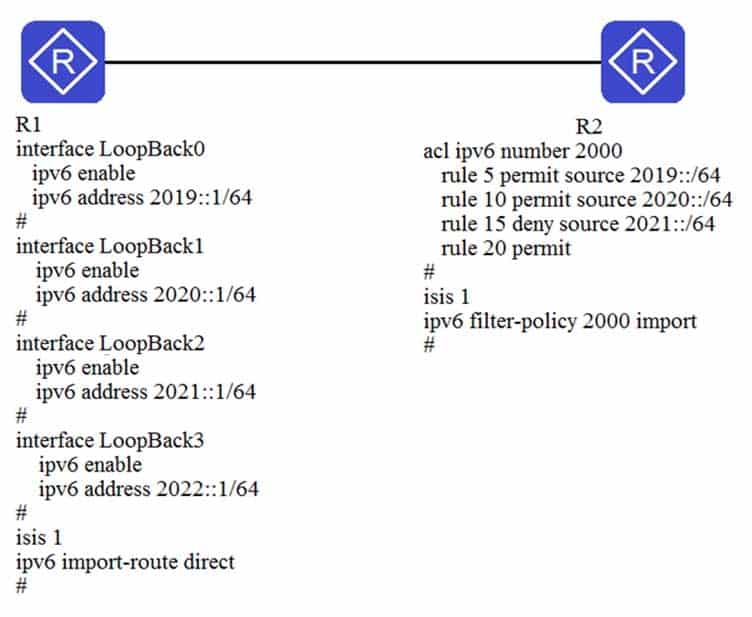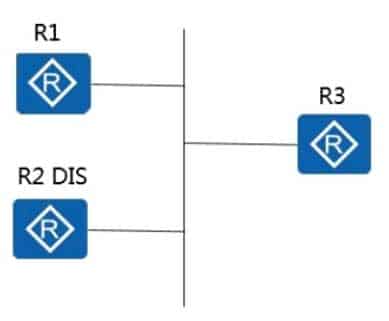H12-261 : HCIE-R&S (Written) (Huawei Certified Internetwork Expert-Routing & Switching) : Part 14
-
The DSCP value of VoIP traffic on Huawei network devices needs to be set to EF. According to the RFC about DSCP, which value should EF be set to?
- 5 in decimal notation
- 101110 in binary notation
- 0xEF
- 36 in decimal notation
-
Which of the following statements regarding FTP is true?
- In FTP passive mode, the client initializes TCP control and data sessions
- In FTP active mode, the server uses the PORT command to notify the client of the port through which data is transmitted
- FTP always uses a TCP session to transmit control and data information
- FTP always uses TCP port 20 to establish a data session and TCP port 21 to establish a control session
- FTP always uses TCP port 21 to establish a data session and TCP port 20 to establish a control session
-
Which of following statements regarding VRRP groups in load balancing mode are true?
- Hosts in the same LAN need to be configured with different virtual routers as their default gateways
- At least two virtual routers need to provide forwarding services simultaneously
- When configuring the priority, ensure that the same router functions as the master device for three VRRP groups
- Multiple VRRP groups can be created on an interface of a router. The router functions as a master device of a VRRP group or a backup device of other VRRP groups
-
Which of the following route types is used to advertise external routes in BGP EVPN?
- Type 2
- Type 5
- Type 1
- Type 4
- Type 3
-
Assume R1 and R2 have a valid level-2 ISIS peering for IPv6 and the additional configuration shown is applied. Which of the following statements about routing entries on R2 are true?

H12-261 HCIE-R&S (Written) (Huawei Certified Internetwork Expert-Routing & Switching) Part 14 Q05 057 - 2022:: /64 will be displayed in the IPv6 routing table.
- 2021:: /64 will be displayed in the IPv6 routing table.
- 2019:: /64 will be displayed in the IPv6 routing table.
- 2020:: /64 will be displayed in the IPv6 routing table.
-
Which of the following combinations will provide the optimal solution for deploying a loop-free Layer 2 network?
- TRILL + MSTP
- Stack + link aggregation
- Link set + MSTP
- Stack + MSTP
-
Which of the following statements regarding MUX VLANs on Huawei switches is true?
- A MUX VLAN consists of principal VLANs and subordinate VLANs. Subordinate VLANs are classified into separate VLANs and isolated VLANs.
- A principal port can communicate with all ports in a MUX VLAN.
- MUX VLANs and super VLANs can be used together in one VLAN.
- Each separate VLAN can be bound to multiple principal VLANs.
-
During troubleshooting for a LAN where Huawei devices are deployed, you find that there are a large number of unicast frames with unknown source MAC addresses. What is the most severe impact these unicast frames have on the switch?
- TCAM entries are occupied
- The power consumption is increased
- The available MAC address entries are consumed
- The available bandwidth is consumed
- The memory for buffering frames is occupied
-
Interface Serial 0 of a router is enabled for OSPF Area 1, Serial 0 is configured as a silent interface. What is the impact of this configuration?
- The OSPF router receives updated routes from its neighbor
- The OSPF router establishes an available adjacency through this interface
- The OSPF router does not add the routes learned from the interface to the local routing table
- The OSPF router does not establish any adjacency through this interface
-
Which of the following route selection tools is unique for BGP?
- Route-policy
- IP-prefix
- ACL
- AS-Path-filter
-
If no default route exists in the local IP routing table, the default-route imported command can be executed to advertise default routes to BGP peers or BGP peer groups.
- True
- False
-
Which of the following statements about IS-IS LSDB synchronization on the broadcast network, shown in the diagram, is true?

H12-261 HCIE-R&S (Written) (Huawei Certified Internetwork Expert-Routing & Switching) Part 14 Q12 058 - R2 functions as the DIS and periodically sends CSNPs
- R2 functions as the DIS and sends Hello PDUs at an interval three times that of non-DIS routers
- R1 and R3 maintain the LSDB consistency by sending PSNPs periodically
- R2 functions as the DIS and does not receive PSNPs from other routers
-
OSPFv3 is a version of OSPF for IPv6 and is different from OSPFv2. OSPFv3 is based on links but OSPFv2 is based on network segments. Which of the following statements is false?
- When an OSPFv3 router obtains routing information from a neighbor, it uses the link-local address of the neighbor as the next hop for packet forwarding.
- Two OSPF routers on the same physical link can still establish a neighbor relationship even if no unicast IPv6 address is configured.
- Two OSPF routers on the same physical link can still establish a neighbor relationship even if their IPv6 addresses are on different networks.
- Except for virtual links, all OSPFv3 interfaces use a link-local address as the destination address of OSPFv3 message.
-
On a P2P network, CSNPs are not sent during the establishment of an IS-IS neighbor relationship.
- True
- False
-
IPv6 devices can obtain information such as the interface address, gateway address, and DNS address through DHCPv6.
- True
- False
-
The Next Header field only exists in the basic header of an IPv6 packet, and its function is only to indicate whether the IPv6 packet has an extension header.
- True
- False
-
Which of the following statements regarding features of the inter-AS VPN Option C are true?
- VPN routes are directly exchanged between the ingress PE and the egress PE, and the routes do not need to be stored or advertised by the intermediate devices.
- The inter-AS VPN Option C mode is not applicable to scenarios where multiple Ass are spanned.
- A maximum of two labels are required for packet forwarding.
- ASBRs do not store VPNv4 routes or advertise VPNv4 routes to each other.
-
Which of the following statements correctly describe the LDP session establishment process?
- The label switching router (LSR) with the larger transport address initiates a TCP connection.
- After two devices receive a Keepalive message from each other, the LDP session is successfully established.
- LDP Neighbor Discovery Hello messages are encapsulated using TCP with the multicast destination address of 224.0.0.2.
- After the TCP connection is successfully established, the active party sends an Initialization message to negotiate with the passive party about parameters used for establishing an LDP session.
-
On an MPLS BGP VPN where MPLS Penultimate Hop Popping (PHP) is disabled, when packets arrive at the last-hop PE, packets carry two MPLS labels which can be the same value.
- True
- False
-
On a multicast network, in which of the following situations can multicast traffic not be forwarded?
- There are not any RPF route in the router
- The upstream router discards the received PIM Join message
- PIM is disabled on the RPF interface
- On a multi-router egress network, the local router is not a DR
Subscribe
0 Comments
Newest